[1]
Ü. Özgür, Ya. I. Alivov, C. Liu et al., A comprehensive review of ZnO materials and devices, J. Appl. Phys. 98 (2005) 041301.
Google Scholar
[2]
J. F. Wager, Transparent electronics, Science 300 (2003) 1245-1246.
Google Scholar
[3]
W. Y. Liang, A. D. Yoffe, Transmission spectra of ZnO single crystals, Phys. Rev. Lett. 20 (1968) 59-62.
DOI: 10.1103/physrevlett.20.59
Google Scholar
[4]
X. Jiang, F. L. Wang, M. K. Fung et al., Aluminum-doped zinc oxide films as transparent conductive electrode for organic light-emitting device, Appl. Phys. Lett. 83 (2003) 1875-1877.
DOI: 10.1063/1.1605805
Google Scholar
[5]
O. Bamiduro, H. Mustafa, R. Mundle et al., Metal-like conductivity in transparent Al: ZnO films, Appl. Phys. Lett. 90 (2007) 252108.
DOI: 10.1063/1.2749836
Google Scholar
[6]
F. A. Jenkins, H. E. White, Fundamentals of optics, fourth ed., New York: McGraw-Hill, 1976. pp.523-526.
Google Scholar
[7]
F. Khan, Vandana, S. N. Singh et al., Sol-gel derived hydrogen annealed ZnO: Al films for silicon solar cell application, Sol. Energ. Mat. Sol. C. 100 (2012) 57-60.
DOI: 10.1016/j.solmat.2011.04.024
Google Scholar
[8]
L. Song, S. Zhang, X. Wu et al., Controllable synthesis of hexagonal, bullet-like ZnO microstructures and nanorods arrays and their photocatalytic property, Ind. Eng. Chem. Res. 51 (2012) 4922-4926.
DOI: 10.1021/ie202253a
Google Scholar
[9]
S. Xu, N. Adiga, S. Ba et al., Optimizing and improving the growth quality of ZnO nanowires arrays guided by statistical design of experiments, ACS Nano. 3 (2009) 1803-1812.
DOI: 10.1021/nn900523p
Google Scholar
[10]
Z. R. Tian, J. A. Voigt, J. Liu et al., Biomimetic arrays of oriented helical ZnO nanorods and columns, J. Am. Chem. Soc. 124 (2002) 12954-12955.
DOI: 10.1021/ja0279545
Google Scholar
[11]
J. H. Choy, E. S. Jang, J. H. Won et al., Soft solution route to directionally grown ZnO nanorods on Si wafer; room-temperature ultraviolet laser, Adv. Mater. 15 (2003) 1911-(1914).
DOI: 10.1002/adma.200305327
Google Scholar
[12]
M. C. Akgun, Y. E. Kalay, H. E. Unalan, Hydrothermal zinc oxide nanowires growth using zinc acetate dehydrate salt, J. Mater. Res. 27 (2012) 1445-1451.
DOI: 10.1557/jmr.2012.92
Google Scholar
[13]
N. Ye, C. C. Chen, Investigation of ZnO nanorods synthesized by a solvothermal method, using Al-doped ZnO seed films, Opt. Mater. 34 (2012) 753-756.
DOI: 10.1016/j.optmat.2011.10.013
Google Scholar
[14]
B. D. Cullity, S. R. Stock, Elements of X-Ray diffraction, third ed., Prentice Hall, (2001).
Google Scholar
[15]
J. G. Yu, X. J. Zhao, Q. N. Zhao, Effect of surface structure on photocatalytic activity of TiO2 thin films prepared by sol-gel method, Thin Solid Films 379 (2000) 7-14.
DOI: 10.1016/s0040-6090(00)01542-x
Google Scholar
[16]
JS. Cho, S. Back, SH. Park et al., Effect of nanotextured back reflectors on light trapping in flexible silicon thin-film solar cells, Sol. Energ. Mat. Sol. C. 102 (2012) 50-57.
DOI: 10.1016/j.solmat.2012.03.031
Google Scholar
[17]
J. S. Cho, S. Baek, J. C. Lee, Surface texturing of sputtered ZnO: Al/Ag back reflectors for flexible silicon thin-film solar cells, Sol. Energ. Mat. Sol. C. 95 (2011) 1852-1858.
DOI: 10.1016/j.solmat.2011.02.007
Google Scholar
[18]
P. Singh, A. K. Chawla, D. Kaur, R. Chandra, Effect of oxygen partial pressure on the structural and optical properties of sputter deposited ZnO nanocrystalline thin films, Mater. Lett. 61 (2007) 2050-(2053).
DOI: 10.1016/j.matlet.2006.08.013
Google Scholar


